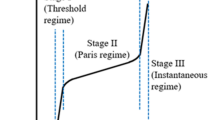Abstract
In order to determine the effects of ΔK ol level on fatigue life, a single peak load was applied at distinct ΔK levels of 7.8×10.3 and 9.8×103 p.s.i. in1/2. Here the ΔK ol level was defined to be a ΔK level at which overload was applied. Three different overload ratios of 1.5, 2.0, and 2.5 were used to determine the overload ratio effect on the recovery factor. The result showed that the recovery factor, Z, was linearly related to ΔK as Z = qΔK+Z o, where q was a function of overload ratio. The value of q decreased as the overload ratio increased in a given ΔK ol level and seemed to be an important factor as well as retardation cycles in determining the fatigue life. For the same overload ratio, specimens that underwent overload at a smaller ΔK ol level showed more improved fatigue life.
Similar content being viewed by others
Abbreviations
- a :
-
Crack length
- a * :
-
Overload affected zone size
- B :
-
Specimen thickness
- (da/dN)ca :
-
Crack growth rate due to constant amplitude fatigue load
- (da/dN)ol :
-
Crack growth rate after overload is applied
- E :
-
Young's modulus
- K :
-
Stress intensity factor
- K min :
-
Minimum stress intensity factor
- K max :
-
Maximum stress intensity factor
- ΔK ol :
-
ΔK level at which overload is applied
- N :
-
Number of cycles
- N D :
-
Number of delayed cycles
- N f :
-
Number of cycles needed for a specimen to be completely fractured
- r p :
-
Assumed plastic zone size
- S :
-
Load
- σys :
-
Yield stress
- W :
-
Width
- Z :
-
Recovery factor
References
E. F. J. Von Euw, R. W. Hertzberg and R. Roberts, “Stress Analysis and Growth of Cracks”, ASTM STP 513 (American Society for Testing and Materials, Philadelphia, PA, 1972) pp. 247–311.
J. R. Rice, “Mechanics of Crack Tip Deformation and Extension by Fatigue”, ASTM STP 415 (American Society for Testing and Materials, Philadelphia, PA, 1967) pp. 49–76.
K. Ohji, K. Ogura and Y. Ohkubo, Eng. Fract. Mech. 7 (1975) 457.
W. Elber, ibid., 2 (1970) 37.
J. Schijve, “Observations on the Prediction of Fatigue Crack Growth Propagation under Variable Amplitude Loading”, ASTM STP 595 (American Society for Testing and Materials, Philadelphia, PA, 1976) pp. 3–23.
C. Bathias and M. Vancon, Eng. Fract. Mech. 10 (1978) 409.
S. G. Russell, ibid. 33 (1989) 839.
N. Yildirim and O. Vardar, ibid. 36 (1990) 71.
G. R. Chanani, Metals Eng. Q. 15 (1975) 40.
G. Jonas and R. P. Wei, Int. J. Fract. 7 (1971) 116.
W. J. Mills and R. W. Hertzberg, Eng. Fract. Mech. 7 (1975) 705.
Author information
Authors and Affiliations
Rights and permissions
About this article
Cite this article
Rhee, K.Y. ΔK ol level effects on fatigue crack propagation. JOURNAL OF MATERIALS SCIENCE 29, 6501–6504 (1994). https://doi.org/10.1007/BF00354011
Received:
Accepted:
Published:
Issue Date:
DOI: https://doi.org/10.1007/BF00354011




